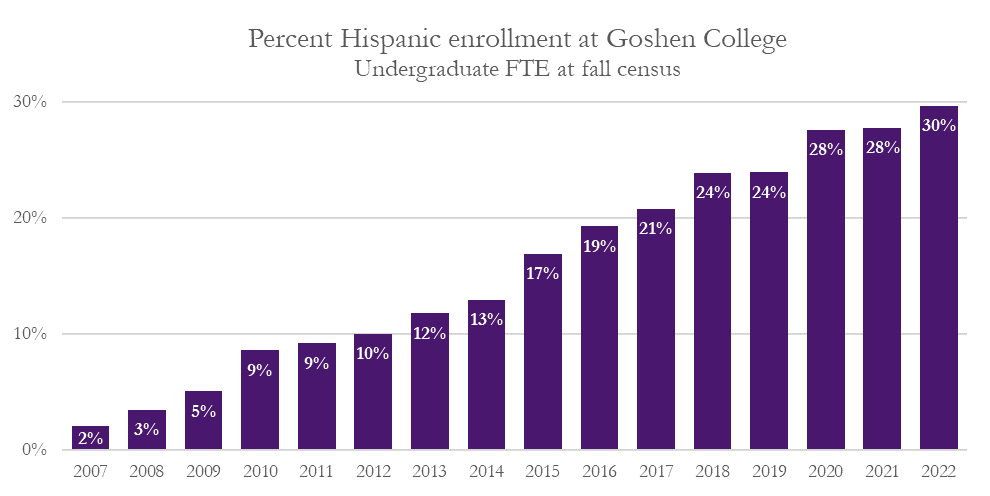Goshen College is poised to become only the third college in Indiana to earn the designation Hispanic Serving Institution, which requires that Latinos make up at least 25% of the undergraduate student body.
The designation, which Goshen College would share with Calumet College of St. Joseph and Indiana University Northwest, is expected to happen next year when the college submits a final key application form.“I feel a lot of pride,” said Gilberto Perez Jr., the vice president for Student Life and dean of students. “We have become a place where we all learn more about Latino culture. We’re all more educated and ready to engage this growing population with the seismic shift that’s happening in this country with Latinos.”
The designation is not a grant; instead, it would give the college opportunities to apply for particular grants. In addition, it would increase educational opportunities for Hispanic students and improve their academic achievement, extending and strengthening academic offerings, program quality, and institutional stability.
Those who have been part of the campus community for many years know that this designation has been a long time coming.
“Goshen College has been working with Latino students for decades,” Perez said. “The first Latino to show up at GC came from Chicago in the 1920s.”
In 2006, GC received a $12.5 million Lilly Endowment grant for specific outreach to the Hispanic community in Goshen.
That same year, the population of Hispanic students was 4%. In 2022, Goshen is at 30% for full-time undergraduate students.
The HSI program is part of a system of federal grants from the Department of Education called Title Five.
To be eligible for the Title Five program, a college must first be eligible for Title Three. Title Three is designed to provide more federal aid, particularly for institutions that are serving students that would need more resources.
Title Three requires two items: the first is that the percentage of students receiving Pell grants has to be greater than the national average for the set of colleges that are in a college’s category. In GC’s case, the category is four-year private colleges.
Last year, GC applied for eligibility despite not quite meeting the Pell grant percentage. The national average is 35%, while GC was at 34%. A waiver was submitted and accepted.
“We did submit a waiver telling them why we thought we were still a college that would serve a population that needed support from this program,” said Justin Heinzekehr, director of institutional research and assessment.
The second criterion relates to the college’s operating expenses per student, which should be below the national average.
For Title Five, a school needs to have at least 25% of Hispanic students in full-time undergraduate enrollment.
Goshen College passed 25% in 2020. However, there is a two-year lag when the data is reported to the federal government system.
Heinzekehr explained: “The system looks at our official reported data to iPads, this is how we report data to the government…that always lags behind usually by two years by the time that we report it, and then they have to clean the data.”
This year, GC will most likely submit its Title Five application in January, allowing for specific HSI designation.
Last year, the DOE opened the application cycle in January and GC heard back by the middle of February. It is likely the timeline will be similar this year.
“There is never a guarantee that the Department of Education approves a school’s application, but we are optimistic given our Title Three approval last year,” said Heinzekehr.
“I think people are really excited that it’s been something that’s been on our radar for a while,” Heinzekehr continued, “and it signals the way that we’ve had success in reaching out to Hispanic students.”
“In my opinion, it has been one of the big sort of success stories for Goshen in the last decade,” said Heinzekehr.
When Rebecca Stoltzfus first became president of Goshen College, she had many conversations with employees and students. Amidst the growing Latino student population, one concern was how to embrace and focus on Latino students while not ignoring other students of marginalized backgrounds.
“We just need to keep in mind the totality of what we want to be as a campus, which is to be a place where many, many types of students can belong to a place, to grow and be educated in ways that are really affirming to them,” Stolzfus said.
“I hope that this particular designation is just one example of how Goshen College is student-centered in general,” she said.



